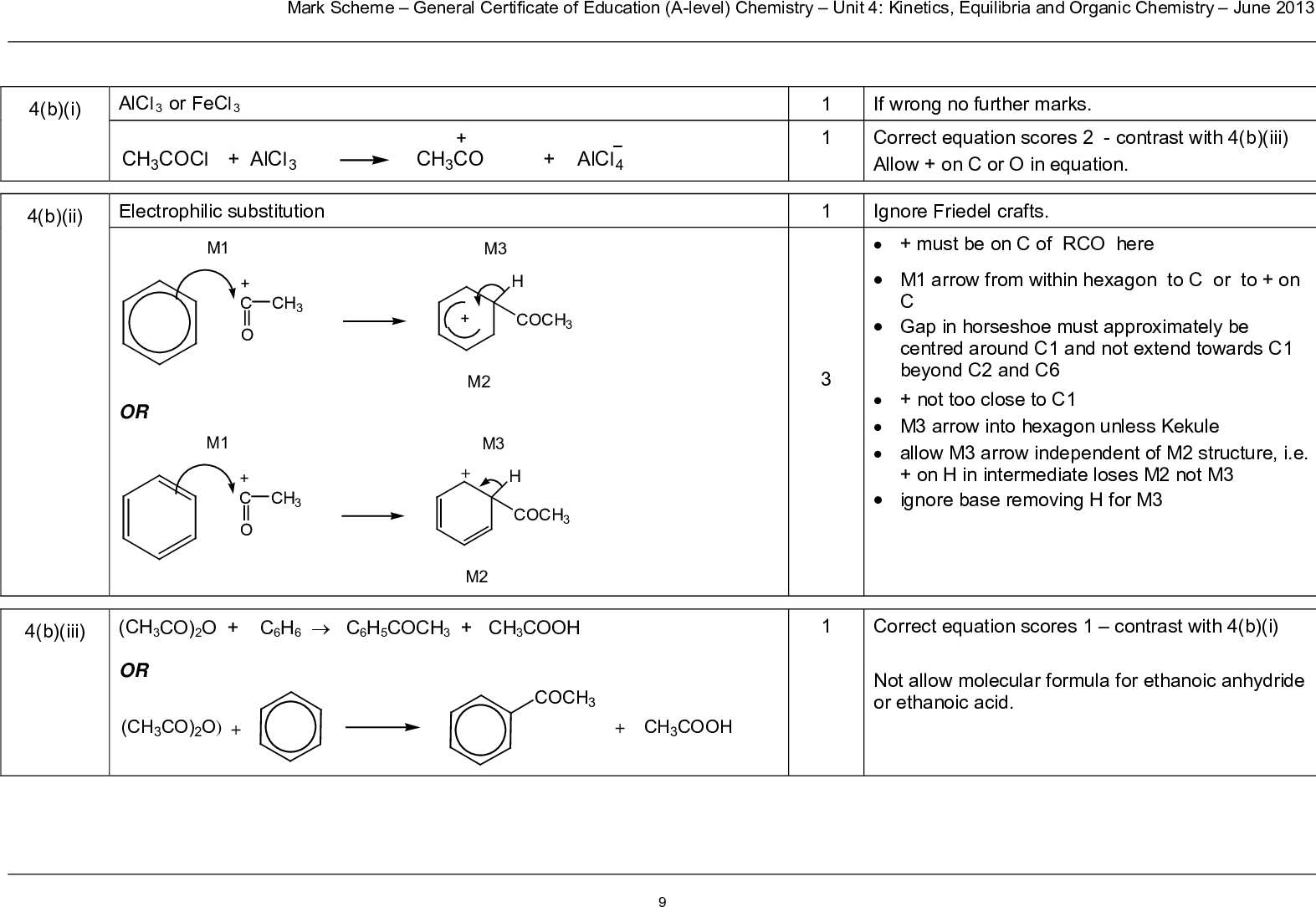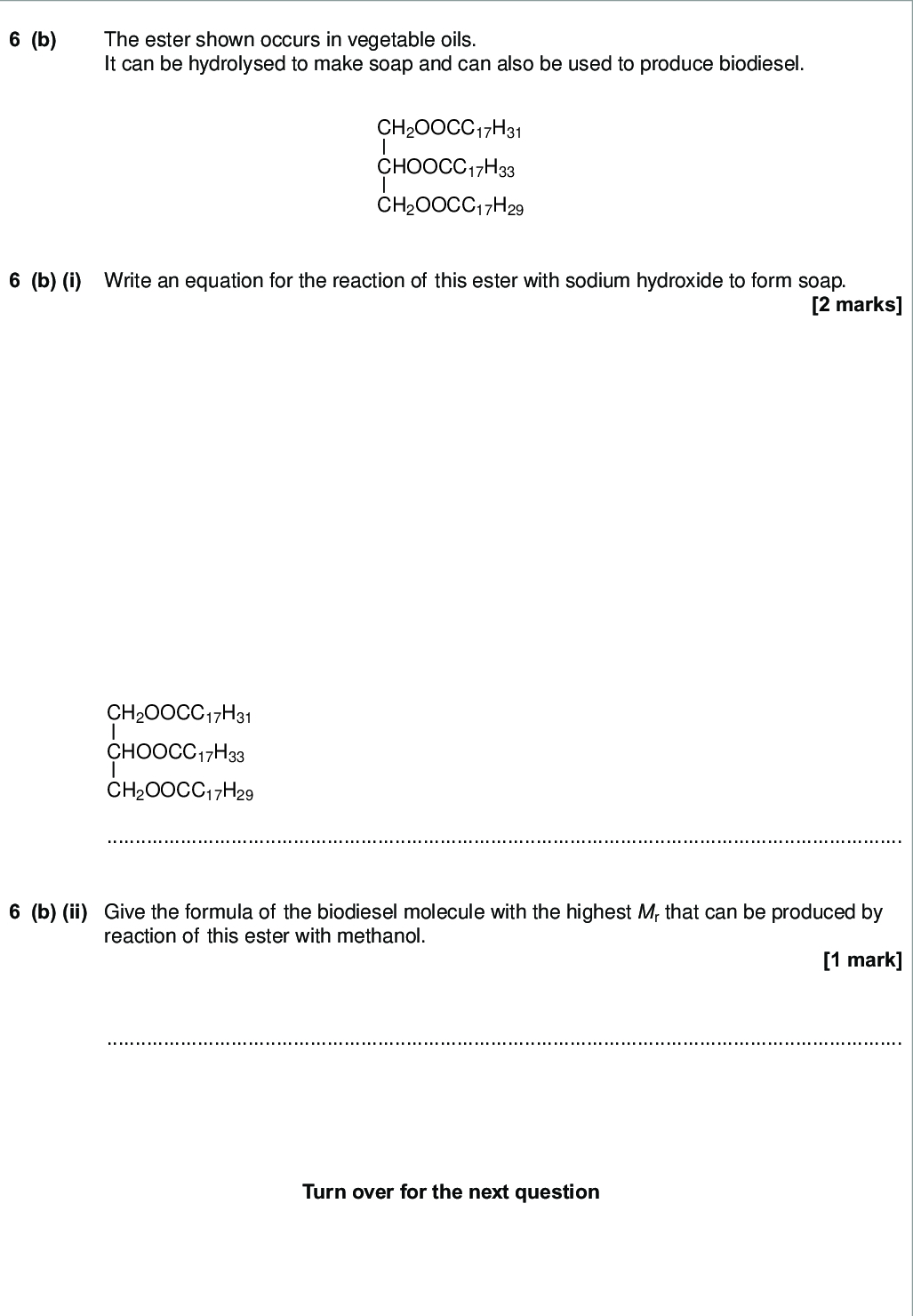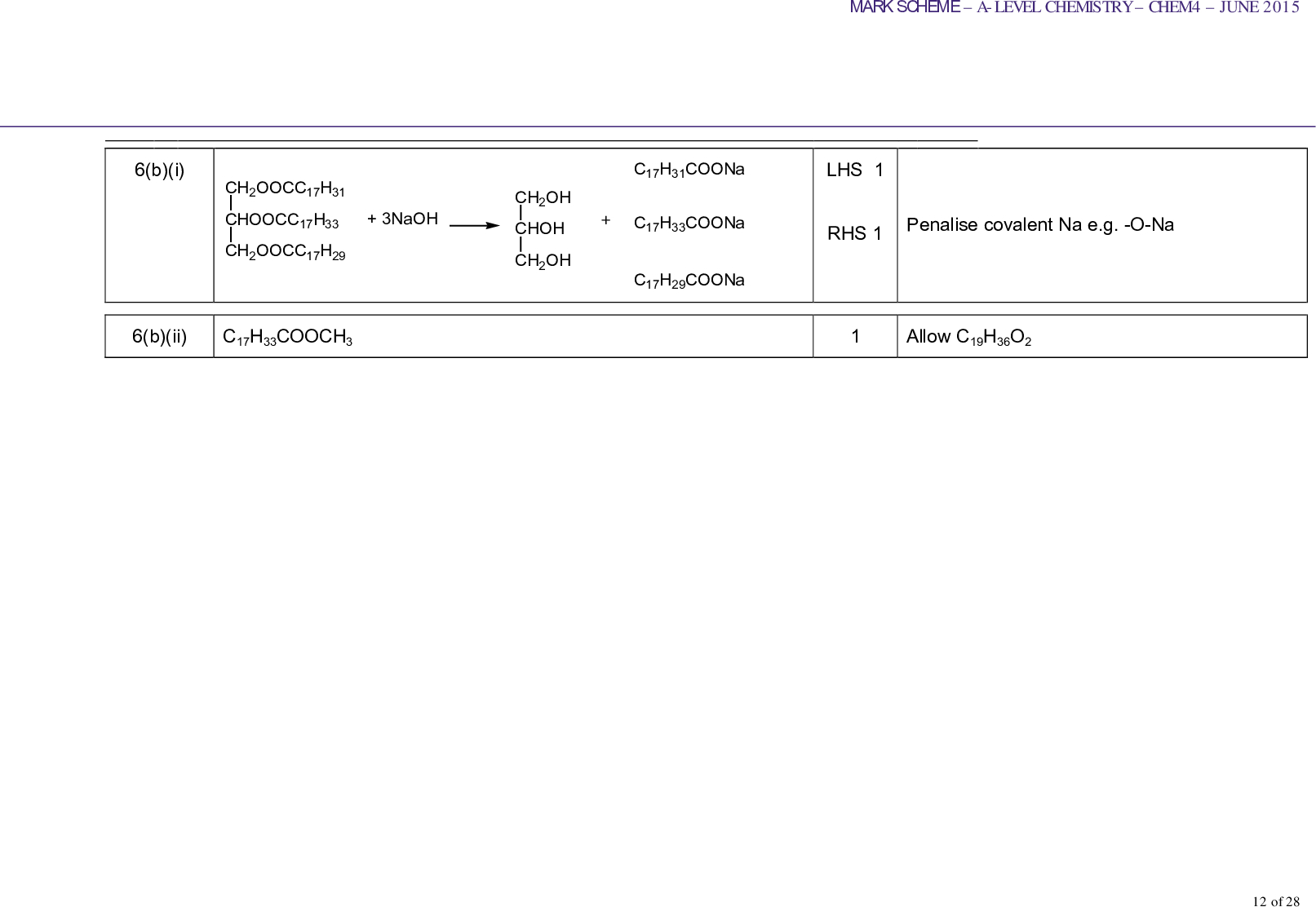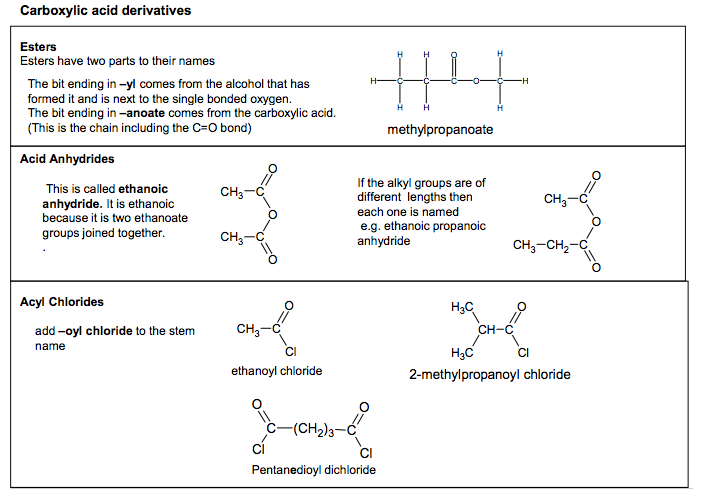
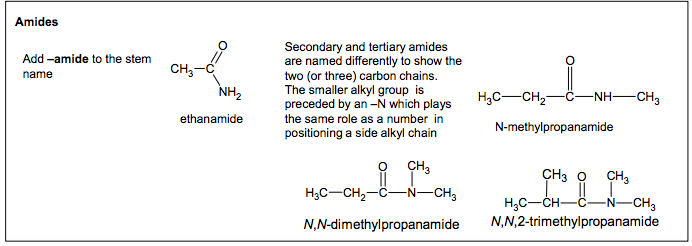
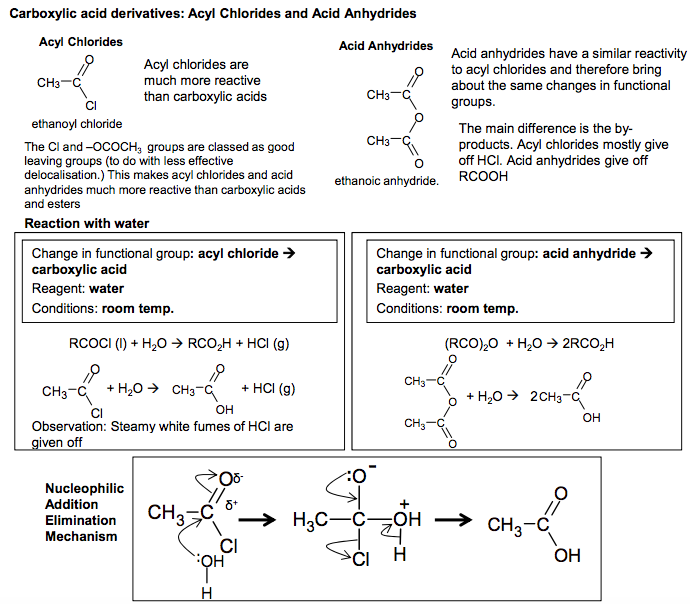
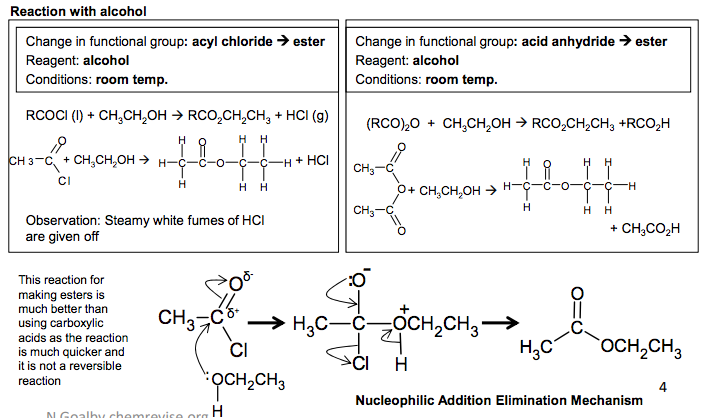
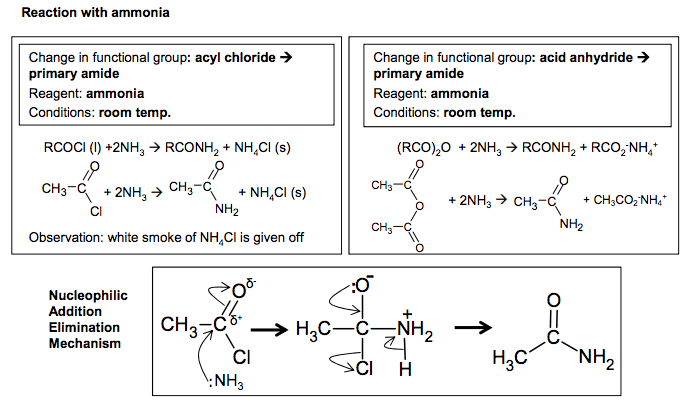
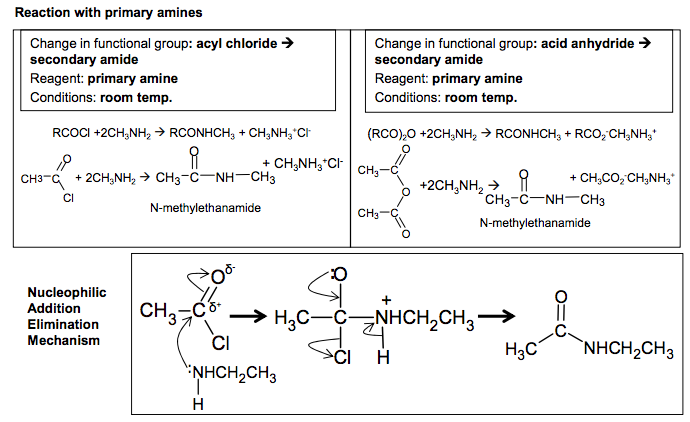

Carboxylic acid derivatives Esters Esters have two parts to their names C C C O O C H H H H H H H H The bit ending in –yl comes from the alcohol that has formed it and is next to the single bonded oxygen. The bit ending in –anoate comes from the carboxylic acid. (This is the chain including the C=O bond) methylpropanoate Acid Anhydrides This is called ethanoic anhydride. It is ethanoic because it is two ethanoate groups joined together. . If the alkyl groups are of different lengths then each one is named e.g. ethanoic propanoic anhydride CH3 C O O CH3 C O CH3 C O O CH2 C O CH3 Acyl Chlorides add –oyl chloride to the stem name CH3 C O Cl ethanoyl chloride Amides Add –amide to the stem name CH3 C O NH2 ethanamide Secondary and tertiary amides are named differently to show the two (or three) carbon chains. The smaller alkyl group is preceded by an –N which plays the same role as a number in positioning a side alkyl chain H3C CH2 C O NH CH3 N-methylpropanamide H3C CH2 C O N CH3 CH3 N,N-dimethylpropanamide H3C CH C O N CH3 CH3 CH3 N,N,2-trimethylpropanamide CH C H3C H3C O Cl 2-methylpropanoyl chloride Pentanedioyl dichloride. Carboxylic acid derivatives: Acyl Chlorides and Acid Anhydrides Acid Anhydrides ethanoic anhydride. CH3 C O O CH3 C O Acyl Chlorides CH3 C O Cl ethanoyl chloride Acid anhydrides have a similar reactivity to acyl chlorides and therefore bring about the same changes in functional groups. The main difference is the by- products. Acyl chlorides mostly give off HCl. Acid anhydrides give off RCOOH Acyl chlorides are much more reactive than carboxylic acids The Cl and –OCOCH3 groups are classed as good leaving groups (to do with less effective delocalisation.) This makes acyl chlorides and acid anhydrides much more reactive than carboxylic acids and esters Reaction with water Change in functional group: acyl chloride carboxylic acid Reagent: water Conditions: room temp. Change in functional group: acid anhydride carboxylic acid Reagent: water Conditions: room temp. RCOCl (l) + H2O RCO2H + HCl (g) (RCO)2O + H2O 2RCO2H CH3 C O Cl + H2O CH3 C O OH + HCl (g) CH3 C O O CH3 C O CH3 C O OH + H2O 2 Observation: Steamy white fumes of HCl are given off Nucleophilic Addition Elimination Mechanism Change in functional group: acyl chloride ester Reagent: alcohol Conditions: room temp. Change in functional group: acid anhydride ester Reagent: alcohol Conditions: room temp. RCOCl (l) + CH3CH2OH RCO2CH2CH3 + HCl (g) (RCO)2O + CH3CH2OH RCO2CH2CH3 +RCO2H CH 3 C O Cl + CH3CH2OH + HCl CH3 C O O CH3 C O Observation: Steamy white fumes of HCl are given off Reaction with alcohol C C O O C C H H H H H H H H C C O O C C H H H H H H H H + CH3CH2OH + CH3CO2H Nucleophilic Addition Elimination Mechanism This reaction for making esters is much better than using carboxylic acids as the reaction is much quicker and it is not a reversible reaction. Reaction with ammonia Change in functional group: acyl chloride primary amide Reagent: ammonia Conditions: room temp. Change in functional group: acid anhydride primary amide Reagent: ammonia Conditions: room temp. RCOCl (l) +2NH3 RCONH2 + NH4Cl (s) (RCO)2O + 2NH3 RCONH2 + RCO2 -NH4+ CH3 C O Cl + 2NH3 + NH4Cl (s) CH3 C O O CH3 C O + 2NH3 Observation: white smoke of NH4Cl is given off CH3 C O NH2 CH3 C O NH2 + CH3CO2 -NH4+ Nucleophilic Addition Elimination Mechanism Reaction with primary amines Change in functional group: acyl chloride secondary amide Reagent: primary amine Conditions: room temp. Change in functional group: acid anhydride secondary amide Reagent: primary amine Conditions: room temp. RCOCl +2CH3NH2 RCONHCH3 + CH3NH3+Cl- (RCO)2O +2CH3NH2 RCONHCH3 + RCO2 -CH3NH3+ CH3 C O Cl+ 2CH3NH2 + CH3NH3+Cl- CH3 C O O CH3 C O +2CH3NH2 + CH3CO2 -CH3NH3+ N-methylethanamide N-methylethanamide Nucleophilic Addition Elimination Mechanism C NH CH3 O CH3 C NH CH3 O CH3 – C Cl H C3 NH2 O H CH3 C O Cl : δ + δ – + : NH3 H C3 C NH2 O CH3 C O Cl : δ + δ – + : NHCH2CH3 H C Cl H C3 NHCH2CH3 O H H3C C NHCH2CH3. Aspirin is made from 2- hydroxybenzoic acid which contains a phenol group. In the reaction the phenol group is turned into an ester by reacting it with the reactive ethanoic anhydride Ethanoic anhydride is used instead of acid chlorides because it is cheaper, less corrosive, less vulnerable to hydrolysis, and less dangerous to use.
/
~
~
~
/
3.3.9.2 Acylation (A-level only)
The structures of:
• acid anhydrides
• acyl chlorides
• amides.
The nucleophilic addition–elimination reactions of water, alcohols, ammonia and primary amines with acyl chlorides and acid anhydrides.
The industrial advantages of ethanoic anhydride over ethanoyl chloride in the manufacture of the drug aspirin.
Students should be able to outline the mechanism of nucleophilic addition–elimination reactions of acyl chlorides with water, alcohols, ammonia and primary amines.


 3.9 Carboxylic Acids And Derivatives Page 4 - 5
3.9 Carboxylic Acids And Derivatives Page 4 - 5 Oxford Textbook Pages : 422 - 426
Oxford Textbook Pages : 422 - 426 CGP Revision Guide Pages : 168 - 169
CGP Revision Guide Pages : 168 - 169














